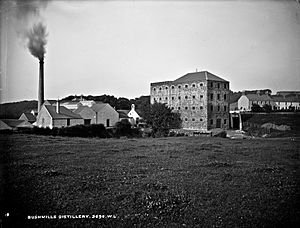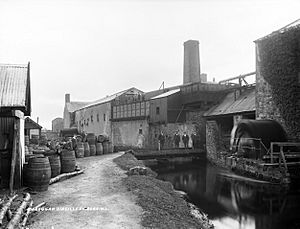Irish whiskey facts for kids
| Type | Distilled beverage |
|---|---|
| Country of origin | Ireland |
| Introduced | 13th–15th century |
| Alcohol by volume | 40–94.8% |
| Proof (US) | 80–189.6° |
| Colour | Pale gold to dark amber |
| Flavour | smooth, sharp, hint of vanilla |
| Ingredients | Malt, water |
| Variants |
|
| Related products | Scotch whisky |
Irish whiskey is a type of whiskey made on the island of Ireland. The word 'whiskey' comes from the Irish words uisce beatha, which means water of life. Long ago, Irish whiskey was one of the most popular drinks in the world. However, its popularity went down a lot from the late 1800s onwards.
Contents
The Story of Irish Whiskey
Irish whiskey was one of the first alcoholic drinks to be made by distilling in Europe. This started around the 12th century. People believe that Irish monks learned how to distill perfumes during their travels in southern Europe around 1000 AD. They then changed this method to make a drinkable spirit.
The "whiskey" made back then was different from what we know today. It wasn't aged in barrels, and people often added herbs like mint or thyme for flavor.
It's hard to find old records of whiskey making in Ireland, especially from the early days when there were no rules. Many people made it secretly, so official records don't show the full picture. Also, many Irish stories were passed down by talking, not writing, so some details are probably lost.
The oldest written record of whiskey in Ireland is from 1405. It says that a clan leader died after drinking too much "aqua vitae" (water of life) at Christmas. By 1556, whiskey was very common. An English law even said that whiskey was "universally" made across Ireland. This law also tried to make it illegal for most people to make spirits without a special permit. But this rule didn't have much effect outside of the Pale, which was a small area around Dublin controlled by the English.
When Whiskey Making Became Official
In 1608, King James I gave a special license to Sir Thomas Phillips to make whiskey in County Antrim. Because of this license, the Old Bushmills Distillery says it has the oldest continuous license to distill in the world.
In 1661, the government started taxing whiskey production in Britain and Ireland. This meant all whiskey makers were supposed to register and pay taxes. For many years, whiskey made by registered distillers was called "parliament whiskey." Whiskey made secretly by illegal producers was called Poitín. This Gaelic word means "small pot," referring to the small stills used by these secret makers.
In the 1700s, more and more people in Ireland wanted whiskey. This was partly because the population grew, and people started drinking less imported spirits. Because of this high demand, some distillers focused on making a lot of whiskey quickly, which sometimes made the quality worse. To fix this, a law was passed in 1759. It said distillers could only use malt, grain, potatoes, or sugar to make whiskey. It also banned some bad ingredients.
Different Kinds of Irish Whiskey
Irish whiskey comes in a few main types. The type depends on the grains used and how it's made. Traditionally, Irish whiskey was made in large pot stills.
Single Malt Irish Whiskey
This whiskey is made only from malted barley. It is distilled in a pot still at one single distillery. This style is also very common for Scotch whisky. It can be distilled two or three times.
Single Pot Still Whiskey
This type of whiskey is made from a mix of malted and unmalted barley. It is completely distilled in a pot still at one single distillery. The main difference from single malt is that it includes raw, unmalted grain. This style was once the most common Irish whiskey before blended whiskeys became popular.
Grain Whiskey
Grain whiskey is made using a different method called continuous distillation. This uses a column or Coffey still instead of a pot still. It can be made from various grains. This spirit is usually lighter and has a more neutral taste. It's rarely sold on its own. Most grain whiskey is used to make blended whiskey.
Blended Whiskey
Blended whiskey is a mix of the other styles. It can be grain whiskey mixed with single malt, or with single pot still whiskey, or both. Blended whiskeys are now the most common type of both Irish and Scotch whiskeys.
Famous Old Distilleries
Over the 1700s and 1800s, about 1,000 registered distilleries opened and closed in Ireland. Many more operated illegally. Most of these old distilleries are now gone. For example, in 1800, Dublin city alone had 40 distilleries.
Only one distillery, Bushmills, has been making whiskey continuously until today. However, the Kilbeggan Distillery, which closed in 1954, has reopened recently. Also, a new distillery was built in Tullamore to replace an old one that closed in 1954.
Here are some of the well-known distilleries that used to operate in Ireland:
- Royal Irish Distillery, Belfast, County Antrim (1868–1938 or later) – This was one of Ireland's biggest distilleries in the 1890s.
- Bandon Distillery, Bandon, County Cork (1826–1929) – This was the largest rural distillery in Ireland.
- Old Midleton Distillery, Midleton, County Cork (1825–1975) – This distillery had the world's largest pot still. It's now a visitor center.
- Bow Street Distillery, Dublin (1780–1971) – Run by John Jameson & Son, this was one of the "big four" Dublin distilleries. It was the original home of Jameson Irish Whiskey. It's now a visitor center.
- John's Lane Distillery, Dublin (1796–1976) – Run by James Power & Son, this was another of the "big four" Dublin distilleries. It was the original home of Power's Irish Whiskey.
- Marrowbone Lane Distillery, Dublin (late 1700s–1920s) – This was also one of the "big four" Dublin distilleries.
- Thomas Street Distillery, Dublin (1757–1926) – Run by the Roe Family, this was once the largest distillery in Britain and Ireland. It was located across from the Guinness' St. James' Gate brewery.
- Dundalk Distillery, County Louth (1708–1926) – This was one of the oldest distilleries in Ireland and had Ireland's largest chimney.
- Old Tullamore Distillery, County Offaly (1829–1954) – Tullamore D.E.W., a very famous Irish whiskey, was first made here.
See also
 In Spanish: Whisky irlandés para niños
In Spanish: Whisky irlandés para niños




